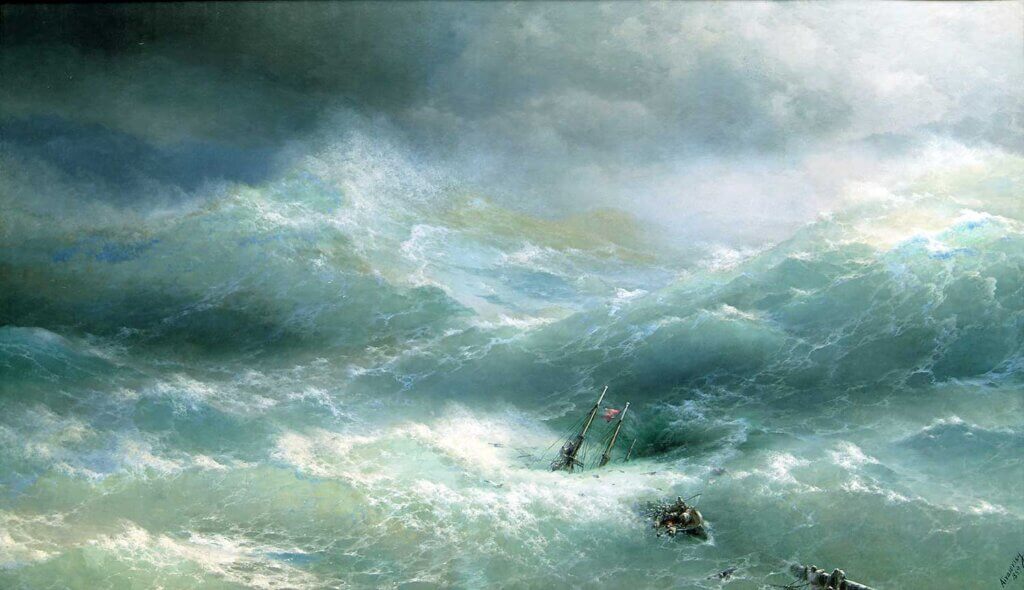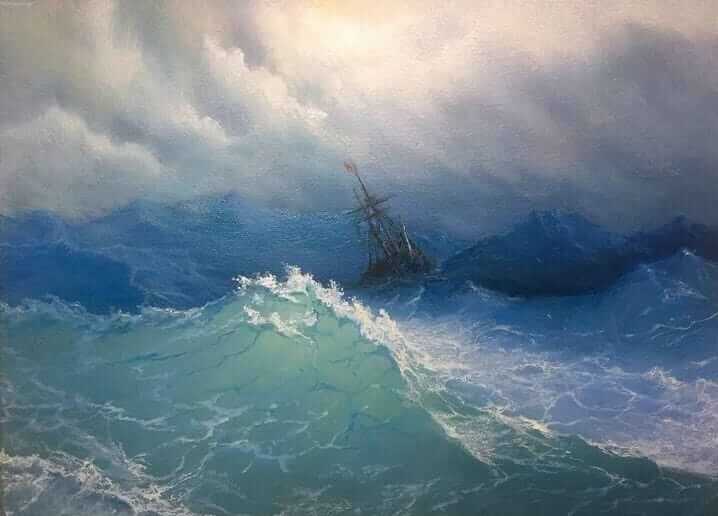Ivan Aivazovsky, born on July 29, 1817, in Feodosia, Crimea, is celebrated as one of the most prominent marine artists in the history of art. His evocative seascapes and dramatic portrayals of the ocean have earned him a revered place in the annals of art history. This article delves into the life, career, and artistic legacy of Aivazovsky, exploring the elements that make his work unique and enduring.
Early Life and Education
Ivan Konstantinovich Aivazovsky was born into an Armenian family in the port town of Feodosia. His early fascination with the sea was influenced by his coastal surroundings. Despite the family’s modest means, Aivazovsky’s talent for drawing became evident at a young age. His potential was recognized by local officials, leading to his enrollment in the Simferopol Gymnasium and later the Imperial Academy of Arts in St. Petersburg.
Academic Training
At the Imperial Academy, Aivazovsky studied under the tutelage of Russian masters like Maxim Vorobiev and Alexander Sauerweid. His education provided a solid foundation in classical art principles, but it was his innate ability to capture the essence of the sea that set him apart. His work quickly gained recognition, and he graduated with a gold medal, which allowed him to study abroad.

Artistic Career
Early Successes
After completing his studies, Aivazovsky embarked on a European tour, visiting Italy, France, and the Netherlands. This journey profoundly influenced his artistic development. In Italy, he was particularly inspired by the works of J.M.W. Turner, whose use of light and color resonated with Aivazovsky’s own artistic vision. By the time he returned to Russia, he had established himself as a master of marine art.
Signature Style
Aivazovsky’s signature style is characterized by his masterful use of light, color, and movement to create dynamic seascapes. His paintings often depict dramatic scenes of storms, shipwrecks, and calm seas bathed in moonlight or sunlight. He had an exceptional ability to render the translucency and power of water, capturing its many moods and forms.
Notable Works
Some of Aivazovsky’s most famous works include “The Ninth Wave” (1850), which is renowned for its dramatic depiction of a monstrous wave and the survivors clinging to the wreckage of their ship. “The Black Sea” (1881) showcases his skill in portraying the vastness and tranquility of the sea, while “The Battle of Chesme” (1848) highlights his ability to depict historical naval battles with accuracy and emotion.
Influence and Legacy
Impact on Marine Art
Aivazovsky’s influence on marine art cannot be overstated. His works set a new standard for the genre, inspiring countless artists to explore the beauty and drama of the sea. His ability to convey the sublime power of nature made his paintings popular among collectors and art enthusiasts worldwide.
Honors and Recognition
Throughout his career, Aivazovsky received numerous accolades and honors. He was appointed a professor at the Imperial Academy of Arts and was awarded the Order of St. Anna and the Order of St. Vladimir. His international reputation was further cemented by exhibitions in Europe and the United States, where his works were met with critical acclaim.
Cultural Contributions
Beyond his artistic achievements, Aivazovsky made significant contributions to his hometown of Feodosia. He funded the construction of an art school, a historical museum, and a library, fostering cultural development in the region. His philanthropy extended to various Armenian causes, reflecting his deep connection to his heritage.
Personal Life
Family and Relationships
Aivazovsky was married twice. His first marriage to Julia Graves, an English governess, ended in divorce. He later married Anna Burnazian, with whom he shared a deep and lasting bond. Despite his busy career, Aivazovsky remained devoted to his family and was known for his kindness and generosity.
Later Years
In his later years, Aivazovsky continued to paint prolifically, producing some of his most celebrated works. He remained active in the art community and continued to exhibit his paintings internationally. He passed away on May 5, 1900, leaving behind a vast legacy of over 6,000 works.
Techniques and Themes

Mastery of Light and Color
Aivazovsky’s mastery of light and color is a defining feature of his work. He skillfully used a limited palette to create depth and atmosphere, often employing shades of blue, green, and gold to evoke the changing moods of the sea. His use of light was particularly innovative, capturing the play of sunlight on water and the luminescence of moonlit waves.
Depiction of Nature’s Power
A recurring theme in Aivazovsky’s work is the sublime power of nature. His storm scenes, in particular, highlight the might and unpredictability of the sea. Through his dynamic compositions and dramatic contrasts of light and shadow, Aivazovsky conveyed the awe-inspiring and often terrifying aspects of the ocean.
Historical and Mythological Subjects
In addition to his seascapes, Aivazovsky painted numerous works depicting historical and mythological subjects. These paintings often featured naval battles, ancient legends, and biblical themes, showcasing his versatility and narrative skill. His historical works, such as “The Battle of Sinop” (1853), are noted for their accuracy and dramatic intensity.
Conclusion
Ivan Aivazovsky’s contributions to art are unparalleled, particularly in the realm of marine painting. His exceptional ability to capture the beauty, power, and majesty of the sea has earned him a lasting legacy. His works continue to be celebrated for their technical brilliance and emotional depth, inspiring generations of artists and art lovers. Aivazovsky’s life and career are a testament to his extraordinary talent and enduring impact on the world of art.























